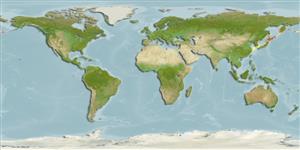Teleostei (teleosts) >
Perciformes/Zoarcoidei (Eelpouts and pricklebacks) >
Bathymasteridae (Ronquils)
Etymology: Bathymaster: Greek, bathys = deep + Greek, master, -eros = somebody that research (Ref. 45335).
Eponymy: Professor Dr Konstantin Michailovich Derjugin (1878–1938) was an oceanographer and marine zoologist at Leningrad State University, and manager of the Oceanic Division of the State Hydrological Institute in Leningrad. [...] (Ref. 128868), visit book page.
Environment: milieu / climate zone / depth range / distribution range
Ecology
Marine; demersal; depth range 0 - 65 m (Ref. 50550). Temperate
Northwest Pacific: Kuril Islands and Tartar Strait to Peter the Great Bay, Japan Sea.
Length at first maturity / Size / Weight / Age
Maturity: Lm 17.8 range ? - ? cm
Max length : 18.0 cm TL male/unsexed; (Ref. 56557)
Short description
Identification keys | Morphology | Morphometrics
Dorsal spines (total): 2; Dorsal soft rays (total): 39 - 40; Anal spines: 1 - 2; Anal soft rays: 29 - 31. Resemble B. leurolepis but easily distinguished by a distinct dark (blue when fresh) blotch on the operculum, and a smaller number of lateral line scales. Attains about 15 cm SL.
Inhabits rocky shore areas.
Pairing observed during breeding (Ref. 205).
Masuda, H., K. Amaoka, C. Araga, T. Uyeno and T. Yoshino, 1984. The fishes of the Japanese Archipelago. Vol. 1. Tokai University Press, Tokyo, Japan. 437 p. (text). (Ref. 559)
IUCN Red List Status (Ref. 130435: Version 2024-1)
Threat to humans
Harmless
Human uses
Tools
Special reports
Download XML
Internet sources
Estimates based on models
Preferred temperature (Ref.
123201): 3 - 18.5, mean 10.3 °C (based on 66 cells).
Phylogenetic diversity index (Ref.
82804): PD
50 = 0.5703 [Uniqueness, from 0.5 = low to 2.0 = high].
Bayesian length-weight: a=0.00389 (0.00180 - 0.00842), b=3.12 (2.94 - 3.30), in cm total length, based on all LWR estimates for this body shape (Ref.
93245).
Trophic level (Ref.
69278): 3.6 ±0.3 se; based on size and trophs of closest relatives
Generation time: 2.9 ( na - na) years. Estimated as median ln(3)/K based on 1
growth studies.
Resilience (Ref.
120179): High, minimum population doubling time less than 15 months (tmax=8+; Fec = 19,720).
Fishing Vulnerability (Ref.
59153): Low vulnerability (10 of 100).
